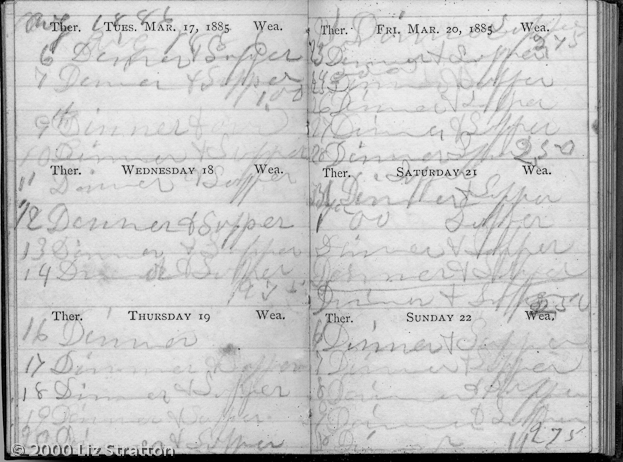 |
| "Bye-Lo-Baby" Wee Babies (1882) |
"Bye-Lo-Baby" is from
Wee Babies, a book belonging to Mira Rockwell (Main) Stratton (1881-1926). Published in 1882, the Bye-Lo-Baby dolls in the poem are not the ones made famous by Grace Storey Putnam in the 1920s. Putnam's 'babies' resembled a three-day-old newborn -- a departure from the more mature dolls depicted in
Wee Babies.
Mira's dolls would have been like those in the illustrations, young children with faces of porcelain or bisque. Beautiful as the dolls may have been, they cannot compare to Mira's own joyous children pictured below. I can't help but wonder what prank was afoot ....
 |
Mira Rockwell (Main) Stratton, Charles W. Stratton III, Virginia Stratton
Reprint, J. Will Hawes, photographer, ca 1920 |
"Mira Main Stockbridge Mass," is inscribed on the first page of
Wee Babies in
an immature cursive scrawl. Mira's mother died when Mira was young. Mira's father, unable to care for his girls, made
arrangements for them to attend a convent school. When Mira became ill, she recuperated with her aunt and namesake, Mira Rockwell, in Stockbridge, Massachusetts.
Mira's father, Isaac
Main (ca 1836-1891), strove to bring the family together, moving closer to Stockbridge and applying for a Civil War service pension; he died before receiving it. Auntie Mira Rockwell filled the void, caring for Mira Main as if she were her own. Mira (Main)
Stratton refers to 'Auntie' frequently and affectionately in her
diary. I like to think of the two Miras sharing bedtime verses from
Wee Babies.
"Go to sleep my precious baby,
Let me think what mama sings,
All about the stars and lammies,
By-lo-land and lots of things."
"By-lo-Land and lots of things" await you at
Sepia Saturday 109.
Sources:
"Bye Lo Babies." Article.
Byelobabies.com. http://http://www.byelobbabies.com/ : accessed 20 January 2012.
Blanchard, Amy E., poetry, and Ida Waugh, illustrations.
Wee Babies: Printed in Colours from Original Designs. New York: E.P. Dutton & Co.; London: Griffith and Farran, 1882. This book was a gift from Charles W. Stratton III and Marita (Dick) Stratton in 1990. The book was part of the family's collection of books.
Civil War and Later Pension Files. Department of Veterans Affairs, Record Group 15. Mira Main, minor's application no. 8541, for service of Isaac G. W. Main. National Archives, Washington, D.C.
Massachusetts. Berkshire County. 1890 U.S. census, 'Special Schedule - Surviving Soldiers, Sailors, and Marines, and Widows." Lenox, Enumeration District (ED) 37, p. 4, Isaac Main. Digital images.
Ancetry.com. http:www.ancestry.com : accessed 25 December 2010.
Massachusetts. Berkshire County. 1900 U.S. census, population schedule. Stockbridge, Enumeration District (ED) 83, p. 1818 (penned), Mira Rockwell household, dwelling 118, family 126. Digital images.
Ancestry.com. http:www.ancestry.com : accessed 27 December 2010.
Massachusetts. Berkshire County. 1910 U.S. census, population schedule.
Stockbridge, Enumeration District (ED) 88, p. 3451 (penned), Mira
Rockwell household, dwelling 17, family 17. Digital images.
Ancestry.com. http:www.ancestry.com : accessed 27 December 2010.
Prisant, Carol.
Antiques Roadshow Collectibles.... New York: Workman Publishing, 2003, p. 275.
Stratton, Mira Rockwell (Main), Charles W. Stratton III and Virginia Stratton. Reprint of a photograph by J. Will Hawes. ca 1920. Privately held by Liz Stratton, [ADDRESS FOR
PERSONAL
USE,] Cincinnati, Ohio. 2012. The photographer was identified by comparing the reprint to original photographs that include Charles W. Stratton III and Virginia Stratton wearing the same clothing in front of the same background.
Stratton, Mira Rockwell (Main). "Line-a-Day Diary." MS. Lee, Massachusetts, 1913-1923.
Privately held by Liz Stratton, [ADDRESS FOR PERSONAL USE,] Cincinnati,
Ohio. 2011.
Stratton Family Traditions. Liz and Dick Stratton, compilers. MSS notes, ca 1991-present. Privately held by Stratton, [ADDRESS FOR
PERSONAL
USE,] Cincinnati, Ohio.


































.jpg)






























